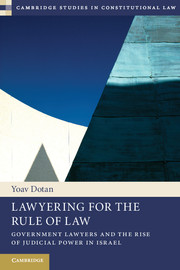Book contents
- Frontmatter
- Dedication
- Contents
- Acknowledgments
- List of figures
- List of tables
- Introduction The government’s lawyer
- 1 The Israeli legal system and the rise of judicial activism in the High Court of Justice
- 2 The High Court of Justice Department (HCJD): overview and history
- 3 Litigating for the government
- 4 The dilemma of serving two masters
- 5 Sorting things out: government lawyers in transformative litigation
- 6 The government lawyer as adjudicator: “pre-petitions” and the HCJD
- Conclusion
- Table of Cases
- Bibliography
- Index
- References
Bibliography
Published online by Cambridge University Press: 05 June 2014
- Frontmatter
- Dedication
- Contents
- Acknowledgments
- List of figures
- List of tables
- Introduction The government’s lawyer
- 1 The Israeli legal system and the rise of judicial activism in the High Court of Justice
- 2 The High Court of Justice Department (HCJD): overview and history
- 3 Litigating for the government
- 4 The dilemma of serving two masters
- 5 Sorting things out: government lawyers in transformative litigation
- 6 The government lawyer as adjudicator: “pre-petitions” and the HCJD
- Conclusion
- Table of Cases
- Bibliography
- Index
- References
- Type
- Chapter
- Information
- Lawyering for the Rule of LawGovernment Lawyers and the Rise of Judicial Power in Israel, pp. 195 - 207Publisher: Cambridge University PressPrint publication year: 2013

